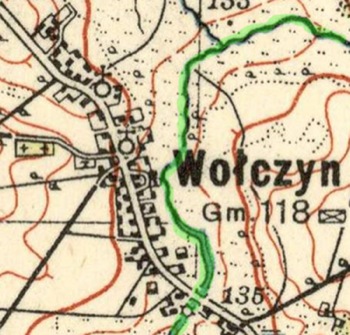
Also: Divin, Drogichin, Khomsk, Malech, Telechany

 |
| The Pulva River, highlighted in bright green, bounding Volchin. The area shown is approximately 2km (1.25 mi) square. A portion of an inter-war 1:100,000 scale maps, courtesy of mapywig.org |
| Editor's Notes: on the north side: more correctly, as can be seen by the map shown above: the east side. The Y in Tych is pronounced as the i in the English word life. There is good authority --an eyewitness-- that the Jews of Wysokie used the same term for the Pulva; they also used it for bathing and laundry. In recent years the Pulva is modest-sized, little more than a stream and fully tamed. Historically, the river was subject to dramatic flooding. Life Guard: it appears that though the Jews bathed in the river, few of them knew how to swim. Bug River: pronounced Boog. The similarity to the English word for insect is unfortunate; there is no connection. |